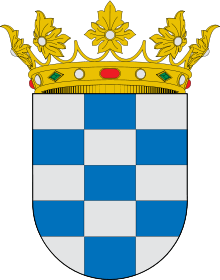Duke of Huéscar

Duke of Huéscar (Spanish: Ducado de Huéscar) is a hereditary title in the Spanish nobility. The title was created in 1563 by King Philip II of Spain, and bestowed on Fadrique Álvarez de Toledo y Enríquez, 6th Marquis of Coria, son and heir of Fernando Álvarez de Toledo, 3rd Duke of Alba. It was granted as a title for the male heirs apparent of the subsequent dukes of Alba, who until then held the marquisate of Coria before succeeding to the dukedom. Its name refers to the village of Huéscar, Granada, one of the manors of the house.
The dukedom was only to be held by the male heirs apparent of the dukes of Alba. María Teresa Álvarez de Toledo, only daughter of Francisco Álvarez de Toledo, 10th Duke of Alba and 11th duchess of Alba after her father's death, was never duchess of Huéscar. It was her son Fernando de Silva, born in his grandfather's lifetime, who received the title at birth. This changed in 1776, when Duke Fernando died without a male heir and his granddaughter, Cayetana, did not have any issue from her marriage to José María Álvarez de Toledo, 15th Duke of Medina Sidonia. She claimed and received the title, becoming the only female holder of the dukedom of Huéscar.
Duchess Cayetana died childless and most of her titles were inherited by her nephew Carlos Miguel Fitz-James Stuart, 7th Duke of Berwick. He did not claim, though, the dukedom of Huéscar, which became dormant. 60 years later, his son Jacobo asked for the resumption of the dormant dukedom. On 6 September 1871, it was restored with a grandeeship of Spain[1] on his son and heir Carlos María, and the title has been held since then by the heirs apparent of the Dukes of Alba, following the tradition. The late duchess of Alba, Cayetana Fitz-James Stuart, was never duchess of Huéscar (instead she was duchess of Montoro, a title held by the eldest daughters of the dukes of Alba), as it was her son Carlos, born in his grandfather's lifetime, who received the title at birth.
Dukes of Huéscar (1563-)
- Fadrique Álvarez de Toledo, 4th Duke of Alba and 1st Duke of Huéscar (1537-1585)
- Fernando Álvarez de Toledo, 2nd Duke of Huéscar (1582-1584), only son of the 1st Duke.
- Antonio Álvarez de Toledo, 5th Duke of Alba and 3rd Duke of Huéscar (1568-1639), eldest son of the 1st duke's second brother.
- Fernando Álvarez de Toledo, 6th Duke of Alba and 4th Duke of Huéscar (1595-1667), eldest son of the 3rd duke.
- Antonio Álvarez de Toledo, 7th Duke of Alba and 5th Duke of Huéscar (1615-1690), only son of the 4th duke.
- Antonio Álvarez de Toledo, 8th Duke of Alba and 6th Duke of Huéscar (1627-1701), eldest surviving son of the 5th duke.
- Antonio Álvarez de Toledo, 9th Duke of Alba and 7th Duke of Huéscar (1669-1711), eldest son of the 6th duke.
- Francisco Álvarez de Toledo, 10th Duke of Alba and 8th Duke of Huéscar (1662-1739), second son of the 6th duke.
- Fernando de Silva, 12th Duke of Alba and 9th Duke of Huéscar (1714-1776), eldest son of the 8th duke's only daughter.
- Francisco de Silva, 10th Duke of Huéscar (1733-1770), only son of the 9th duke.
- Cayetana de Silva, 13th Duchess of Alba and 11th Duchess of Huéscar (1762–1802), only daughter if the 10th duke.
Dormant (1802–1871)
- Carlos María Fitz-James Stuart, 16th Duke of Alba and 12th Duke of Huéscar (1849-1901)
- Jacobo Fitz-James Stuart, 17th Duke of Alba and 13th Duke of Huéscar (1878-1953), eldest son of the 12th duke.
- Carlos Fitz-James Stuart, 19th Duke of Alba and 14th Duke of Huéscar[2] (b. 1948, from 1951-2015), eldest son of the 13th duke's only daughter.
- Fernando Fitz-James Stuart, 15th Duke of Huéscar[3] (b. 1990, from 2015), eldest son of the 14th duke.
References
- ↑ Soler Salcedo, p. 67.
- ↑ Boletín Oficial del Estado: no. 23, p. 304, 23 January 1951. Retrieved 2010-04-10 (Spanish)
- ↑ Boletín Oficial del Estado: no. 282, p. 49354, 25 November 2015. Retrieved 2015-12-20 (Spanish)
Further reading
- Elenco de Grandezas y Títulos Nobiliarios Españoles, Hidalguía Editions, 2008
- Soler Salcedo, Juan Miguel. Nobleza Española. Grandeza Inmemorial 1520, Editorial Visión, Madrid, 2008. ISBN 978-84-9886-179-2